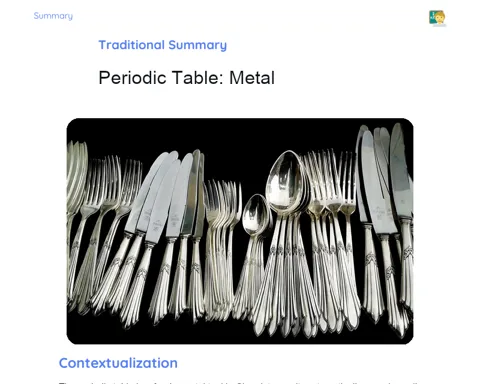Simple and Compound Substances | Socioemotional Summary
Objectives
1. Understand what a chemical substance is and differentiate simple and compound substances.
2. Recognize the existence of allotropes and understand their implications in chemistry.
Contextualization
Did you know that diamond and graphite, despite being so different, are made of the same chemical element, carbon? This fascinating variety is what we call allotropes! Understanding simple and compound substances, as well as allotropes, is not only essential for chemistry but also helps us perceive the complexity and beauty of the world around us. Let's explore these chemical wonders together and discover how they impact our daily lives!
Important Topics
Simple Substances
Simple substances are those formed by atoms of a single chemical element. They are fundamental in chemistry because they represent the purest form of an element. Examples of simple substances include oxygen (O₂), hydrogen (H₂), and nitrogen (N₂). Understanding these substances helps us to comprehend how matter is constituted in its most basic form, allowing us to analyze chemical reactions more accurately and in detail.
-
Composition: Formed by atoms of a single chemical element.
-
Examples: O₂ (oxygen), H₂ (hydrogen), N₂ (nitrogen).
-
Importance: They are the purest form of a chemical element, essential for the study of chemical reactions.
Compound Substances
Compound substances are formed by atoms of two or more different chemical elements. They are the building blocks of all the chemical compounds we encounter in our daily lives, such as water (H₂O), carbon dioxide (CO₂), and sodium chloride (NaCl). These substances show us how different elements can combine to form new and diverse forms of matter.
-
Composition: Formed by atoms of two or more different chemical elements.
-
Examples: H₂O (water), CO₂ (carbon dioxide), NaCl (sodium chloride).
-
Importance: Composed of combinations of elements that result in the formation of compounds with unique properties.
Allotropes
Allotropes are different forms of the same chemical element in the same physical state, with different molecular structures or atomic arrangements. For example, carbon can form both graphite and diamond, which have very distinct physical properties due to their different molecular structures. Allotropes showcase the diversity of chemistry and how small changes in atomic structure can result in significant differences in the properties and uses of materials.
-
Definition: Different forms of the same element in the same physical state.
-
Examples: Graphite and diamond (carbon), O₂ (oxygen) and O₃ (ozone).
-
Importance: Demonstrate how molecular structure impacts the physical and chemical properties of materials.
Key Terms
-
Chemical Substances: Forms of matter with defined chemical composition.
-
Simple Substances: Formed by atoms of a single chemical element.
-
Compound Substances: Formed by atoms of two or more different chemical elements.
-
Allotropes: Different forms of the same chemical element in the same physical state.
To Reflect
-
How can knowledge about simple and compound substances influence our environmental and health decisions in daily life?
-
In what ways can understanding allotropes help us appreciate natural resources and the diversity of nature more?
-
How can the observation and analysis of the properties of chemical substances teach us to observe, analyze, and better understand our own emotions and behaviors?
Important Conclusions
-
We understand that simple substances are formed by atoms of a single chemical element, such as oxygen (O₂) or hydrogen (H₂).
-
We learned that compound substances are formed by atoms of two or more different chemical elements, like water (H₂O) and carbon dioxide (CO₂).
-
We recognize the existence and importance of allotropes, such as graphite and diamond, different structural forms of the same chemical element, carbon.
Impact on Society
Understanding simple and compound substances helps us make more informed and conscientious decisions regarding the use of chemicals in our daily lives. For example, by understanding that water is an essential compound for life, we are motivated to protect our water resources and consume water responsibly. Furthermore, familiarity with substances like carbon dioxide (CO₂) raises awareness about the importance of reducing emissions to mitigate the impacts of climate change.
Allotropes, such as graphite and diamond, show us the wonderful diversity of nature. They teach us that small changes in atomic structure can produce materials with entirely different physical properties. This understanding might inspire us to value natural resources and the diversity of the world around us, leading us to make more sustainable choices and appreciate the intrinsic beauty of science.
Dealing with Emotions
To deal with your emotions while studying this topic, take a moment to reflect on how you feel about the content learned. First, acknowledge those emotions, whether it be curiosity, frustration, enthusiasm, or another feeling. Understand what might be causing those emotions. For example, you might feel challenged by the new knowledge or inspired by the diversity of allotropes. Name those emotions precisely. Finally, try to express your emotions in a healthy way, perhaps by discussing with a friend or writing about your experiences. Regulate your emotions using techniques such as deep breathing or visualizing a calm place to stay focused on your studies.
Study Tips
-
Create study cards with the names and formulas of simple and compound substances, as well as allotropes. This can help you memorize the concepts better.
-
Form discussion groups with your peers to exchange ideas and clarify doubts about the learned content. Teamwork can facilitate understanding of more complex topics.
-
Relate the learned content to everyday situations. For example, observe the products and substances you use at home and try to identify whether they are simple substances, compounds, or allotropes.



